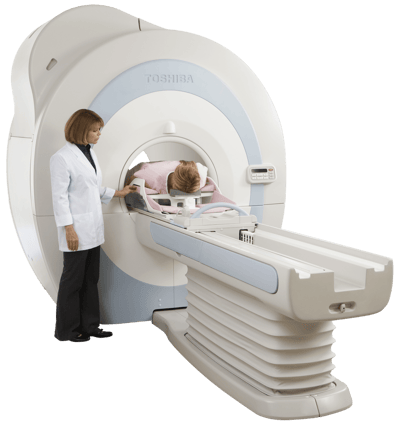 Dating back to the 1970s, the use of mammography in breast cancer screening has proven to save lives. Breast cancer screening has evolved dramatically, however, since those early days of direct-exposure film and the need for high radiation doses. Refinements in technique and technology have enabled doctors to successfully detect and treat more cancers at earlier stages, using less radiation than in the past.[1] Today, radiologists have multiple effective tools available for identifying breast cancers as early as possible to give patients the best chance of recovery.
Dating back to the 1970s, the use of mammography in breast cancer screening has proven to save lives. Breast cancer screening has evolved dramatically, however, since those early days of direct-exposure film and the need for high radiation doses. Refinements in technique and technology have enabled doctors to successfully detect and treat more cancers at earlier stages, using less radiation than in the past.[1] Today, radiologists have multiple effective tools available for identifying breast cancers as early as possible to give patients the best chance of recovery.
3-D Mammography
Digital mammography created more accurate images and used lower doses of radiation than film-based mammography.[2] The most advanced mammograms available today, however, offer even more benefits. 3-D mammography, also known as breast tomosynthesis, has been shown to detect more cancers while returning fewer false-positive results than digital mammography alone.[3],[4] While the earliest 3-D mammogram technology required a double dose of radiation to create both 2-D and 3-D images, modern equipment enables radiologists to capture all needed images using a radiation dose similar to that of a 2-D digital mammogram.
Another tremendous benefit of breast tomosynthesis has been its enhanced ability to detect cancer within dense breast tissue. A 2016 study of 452,320 mammograms demonstrated that tomosynthesis increased detection of invasive breast cancers in women of all breast densities, with the most improvement shown among women with heterogeneously dense breasts.[5] This is great news because women with dense breasts experience a higher rate of breast cancer than women with nondense breasts, and dense breast tissue makes cancers more difficult to identify on mammography images.[6]
High Risk Breast MRI
High risk breast MRI offers additional screening for women who are at a high risk of breast cancer. The average woman faces a 1 in 8 (12.5%) chance of developing breast cancer at some point in her lifetime. For women whose lifetime risk is estimated to be 20% or more or who have a personal history of breast cancer and dense breast tissue, the American College of Radiology recommends breast MRI in addition to mammography screening.[7] (You can calculate your breast cancer risk here).
MRI is especially good at imaging dense breast tissue as well as breast implants, both of which are more difficult to evaluate using mammography alone.[8] While MRI is capable of detecting some cancers not seen on a mammogram, it can also detect other abnormalities that are not cancer as well as miss some signs of cancer that do show up on mammography images. For these reasons, breast MRI is not recommended as a stand-alone screening test for breast cancer.[9]
Abbreviated Breast MRI
Abbreviated breast MRI is a new imaging method that takes just 15–20 minutes, in contrast to a traditional breast MRI, which takes 30–60 minutes to complete. Abbreviated breast MRI is a supplemental screening tool used with mammography that can be especially useful in detecting cancer in women who have dense or very dense breast tissue and less than a 20% lifetime risk of breast cancer. This exam is not currently covered by insurance, but Iowa Radiology offers abbreviated breast MRI for $449. Payment is due at the time of service. A doctor’s order is required for either type of breast MRI exam.
Breast Ultrasound
When X-ray exposure is contraindicated, such as during pregnancy, ultrasound is sometimes used as a breast cancer screening tool. Because it can miss early signs of cancer and is less effective for women with very large breasts, however, ultrasound is not a preferred screening method. Ultrasound can also be used for supplemental breast cancer screening in women who should not undergo MRI.[10]
Today, women and their doctors have a range of advanced imaging methods to detect breast cancer early, when the odds for successful treatment are highest. Iowa Radiology is a Breast Imaging Center of Excellence dedicated to providing state-of-the-art breast cancer screening and diagnosis in Central Iowa. We offer 3-D mammography, breast ultrasound, and both high risk and abbreviated breast MRI as well as imaging-guided biopsy. Feel free to contact us with questions about procedures performed at our clinics, or click here to request a mammography appointment.
[1] Joe, B. and Sickles, E. "The Evolution of Breast Imaging: Past to Present." Radiology, vol. 273, no. 2S, 2014, S23–S44.
[2] Ibid.
[3] Friedewald, Rafferty, et al. "Breast Cancer Screening Using Tomosynthesis in Combination With Digital Mammography." JAMA, vol. 311, no. 24, 2014, pp. 2499–2507.
[4] Skaane, Bandos, et al. "Comparison of Digital Mammography Alone and Digital Mammography Plus Tomosynthesis in a Population-based Screening Program." Radiology, vol. 267, no. 1, 2013, pp. 47–56.
[5] Rafferty, Durand, Conant. "Breast Cancer Screening Using Tomosynthesis and Digital Mammography in Dense and Nondense Breasts." JAMA, vol. 315, no. 16, 2016, pp. 1784–1786.
[6] "Breast Density and Your Mammogram Report." Cancer.org.
[7] Monticciolo, Newell, et al. "Breast Cancer Screening in Women at Higher-Than-Average Risk: Recommendations From the ACR."
[8] "Magnetic Resonance Imaging (MRI)—Breast." Radiologyinfo.org. Radiological Society of North America, 15 Feb 2018. Accessed 1 July 2019.
[9] "Breast MRI Scans." Cancer.org. American Cancer Society, 9 Oct 2017. Accessed 1 July 2019.
[10] "Ultrasound—Breast." Radiologyinfo.org. Radiological Society of North America, 11 April 2018. Accessed 1 July 2019.


